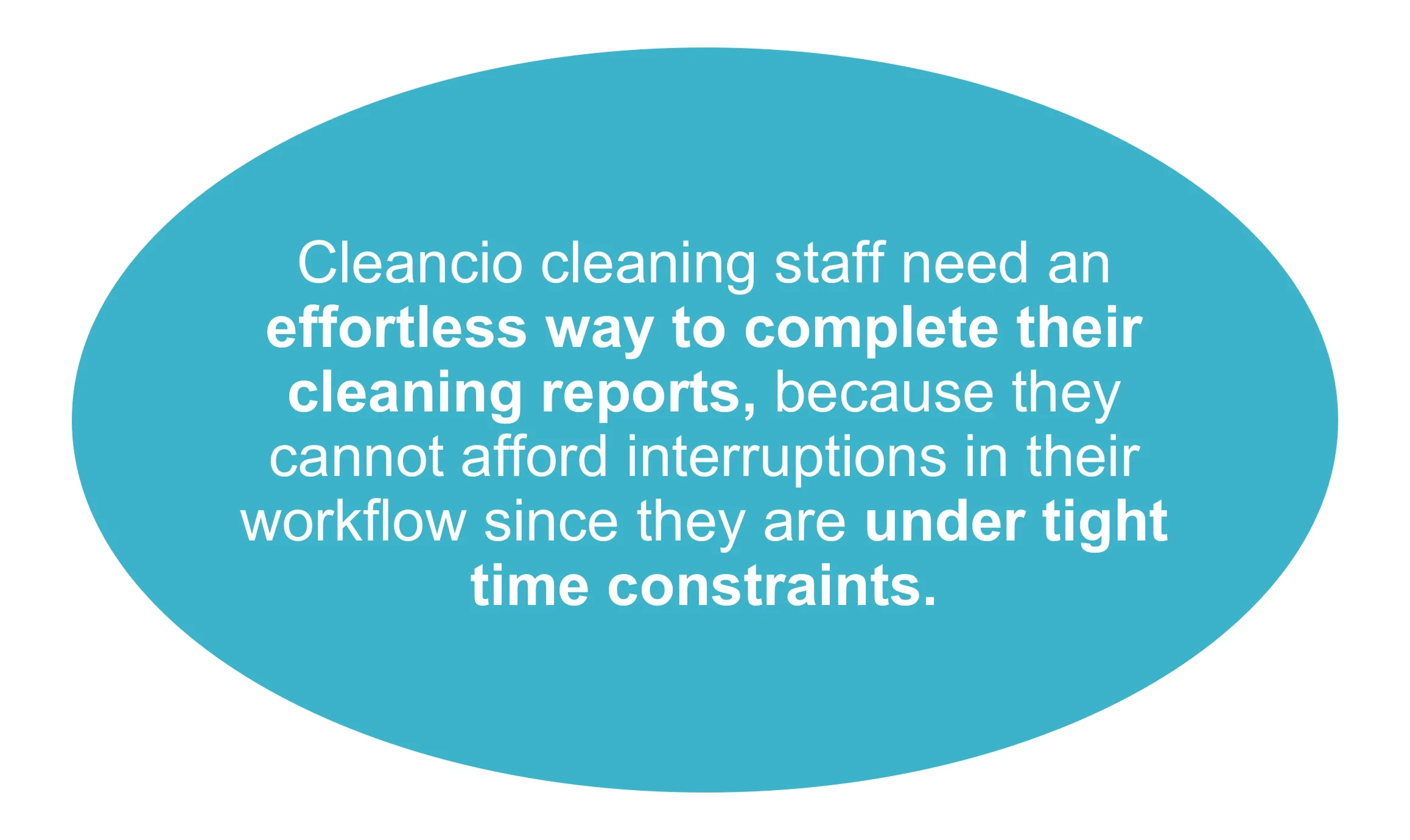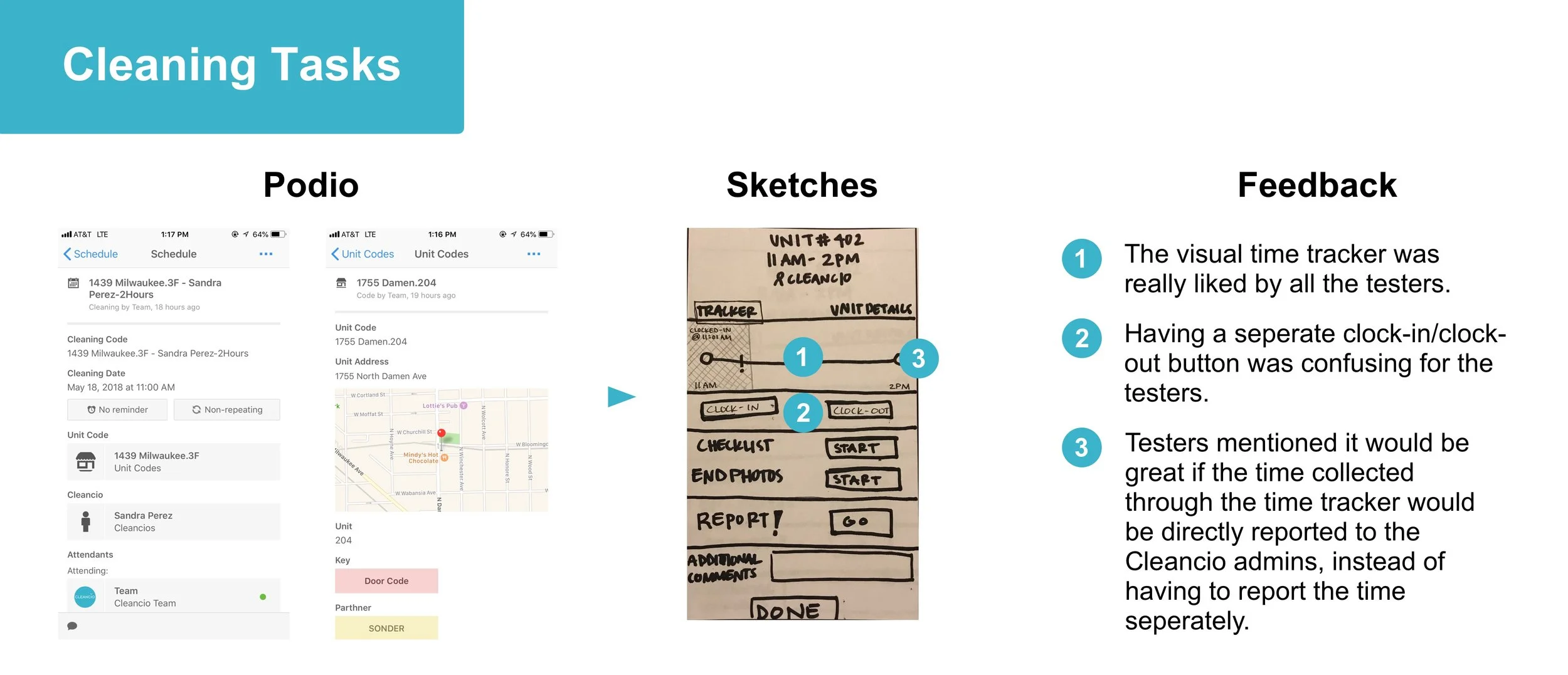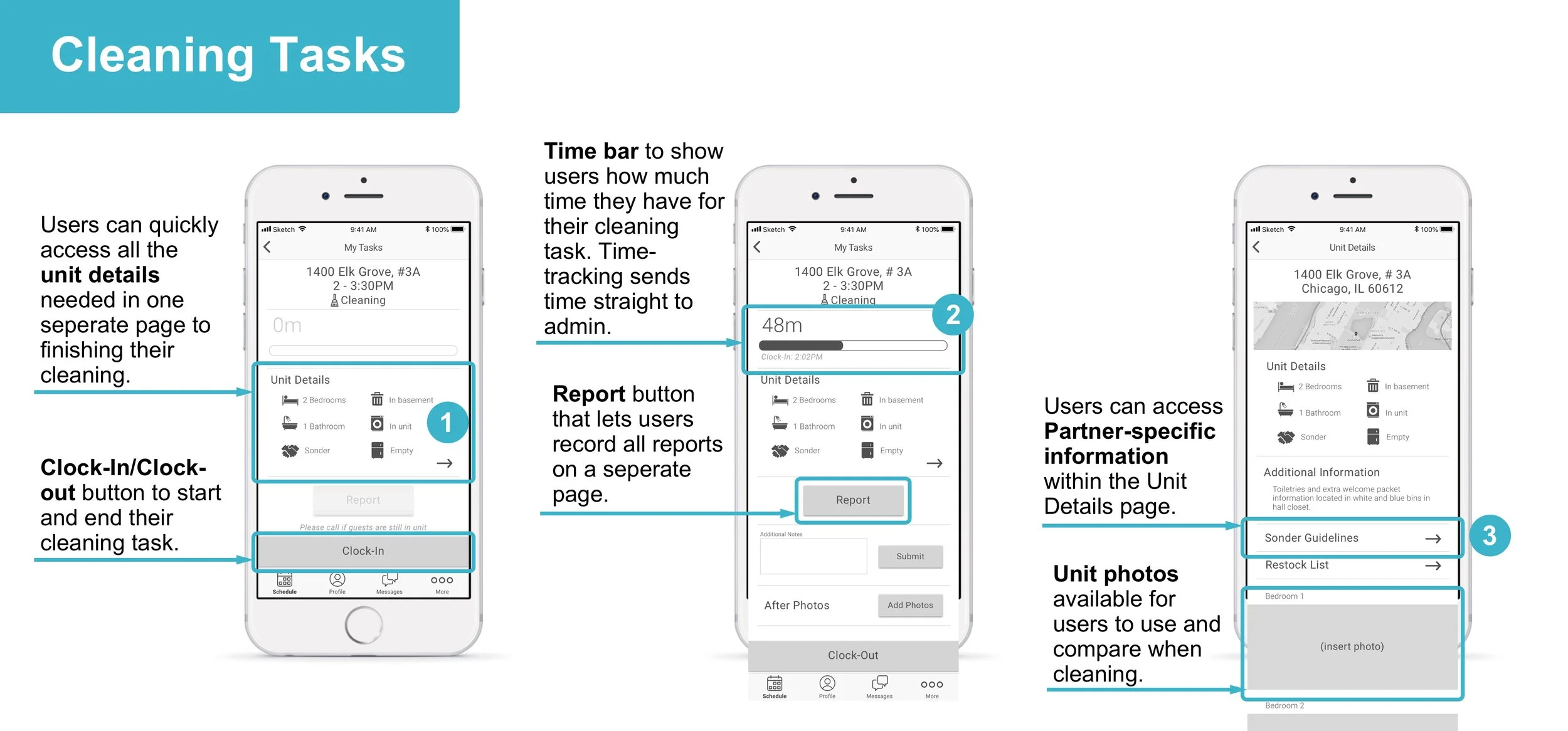Client
Cleancio
Roles
UX Designer & Architect
Tools
Sketch, InVision
Timeframe
3 Weeks
I. The Challenge
Who is Cleancio?
Cleancio is an on-demand vacation rental cleaning and guest turnover service based in Chicago. Their goal is to solve time-consuming and low-quality cleaning by following hospitality standards to clean every property. Through extensive high-quality cleaning, they help Airbnb hosts, vacation rental property managers and owners keep and maintain excellent guest reviews.
To help the company with its business, Cleancio currently pays to use a 3rd-party software management system called Podio for both the Cleancio admins and housekeepers to communicate and keep up with their cleanings. Podio gives their customers the freedom to customize their platform, whether that's adding new pages or deciding what pages go on the mobile navigation. Cleancio admin uses mainly the desktop version of the platform to assign houses/units for the housekeepers to clean. The Cleancio housekeeper uses mainly the mobile version of the platform to get more information about the house/unit they’re cleaning, whether that’s to check the cleaning time, location, and instructions.
The problem & challenge
After a couple of years using the platform and customizing it for Cleancio purposes, a problem arose. The platform has too many pages and features, which causes the Cleancio users to get frustrated with platform architecture. The Cleancio housekeepers have expressed their frustration with the intricate platform as it causes them to lose valuable cleaning time, as they only have about an hour to complete each cleaning. The app has at least 12 different feature pages and not all of them are even used.
Cleancio asked us to design a platform to replace Podio, so it can help simplify and streamline the cleaning process for the Cleancio team.
Prior-known limitations
Since our target users would be Cleancio housekeepers, our client informed us the majority of them spoke mainly Spanish and some English. So from our client kick-off, our team knew we would face a language barrier later on in the project.
From my own personal experience going on mission trips to Mexico, Nicaragua, and Peru, I’ve been put in similar situations where I needed to communicate with someone that didn’t speak the same language. I knew it would be a familiar challenge for me, but wasn’t sure exactly how much it would affect our team as a whole, as we tried to come up with a solution for our client’s problem.
II. Defining the Challenge and Problem
Plans for research
1. Knowing the domain & competition
We wanted to understand the domain of both the vacation rental and cleaning service industry in order to get familiar with the domain spaces. In doing so, we’ll be able to find competitors that have the same goals and features as Cleancio.
2. Identifying and understanding the target user
We needed to understand what difficulties the housekeepers face during their workday. We want to better understand whether the frustrations they encounter are cleaning-related and/or Podio-related.
3. Understanding the current app used, Podio
We wanted to better understand the information architecture of the Podio app, and how Cleancios interact with it on a daily basis. We want to understand the frustrations and pain points of using the Podio app and how it is used by Cleancios and admin users.
Understanding the domain
1. Current growth of the vacation-rental industry
Since the vacation rental industry is projected to grow by 7% in the next 5 years, gross revenue for the vacation rental cleaning industry is estimated to grow from $45 million to $63 million in the next 5 years.
2. Housekeeping's most common problems
Hotel housekeeping has its own set of specific problems, from physical injuries to language barriers. Muscular and tendon strain and respiratory problems are cited as common physical injuries sustained by housekeepers. In addition, language barriers are also a major problem in the housekeeping industry. Since housekeeping jobs are manual labor positions with low barriers of entry, many hotel housekeeping jobs are filled by women who only speak Spanish. This can pose a problem when it comes to guest interaction and employee communication.
3. High turnover for cleaning staffs
The low barriers to entry and labor-intensive nature of this industry result in high turnover among employees. A 2015 survey indicated that “38% of cleaning operations managers said that employee turnover was a challenge when managing a cleaning staff.”
Empathizing with users
At the beginning of this project, our client was able to provide us a list of Cleancio housekeepers to interview, in order to better understand their goal, motivation, and frustrations. As a part of the interviews, our client also offered us the chance to shadow some of the housekeepers on one of their cleaning sessions. Our team scheduled and conducted 2 interviews and 4 contextual inquiries with the Cleancio housekeepers.
This was a great opportunity for our team to conduct a type of interview method called the contextual inquiry. This method involves observing Cleancio housekeepers within their work environment, as they perform their daily tasks in the unit they are cleaning. They’ll be explaining their activities and Podio interactions in real time. As we had them talk through their cleaning process and Podio interaction, we had several questions prepared.
All the Cleancio housekeepers we interviewed spoke very little to no English. We were able to recruit some of our friends to help us as translators by phone. This was not the most ideal situation as this took more time out of our interview/contextual inquiries.
Even with this limitation, we did get a couple of useful insights from the housekeepers, regarding to their frustrations and motivations.
1. Cleaning Frustration
Cleaning frustrations include physical limitations, late guess checkouts, broken household items, etc. Most of these are external factors that are out of their control and not an area that we can focus on and fix as designers.
2. Podio Frustration
The Cleancio interaction with Podio is a long and tedious process when it comes to checking and inputting important information regarding their cleaning.
- Per housing unit, the housekeepers must look at 1 to 2 cleaning checklists, to evaluate what needs to get done.
- If any items within the unit are broken or missing, they need to be reported within the app. Housekeepers need to take pictures and add descriptions for each individual report.
““I don’t like to send pictures here and send pictures there.””
Our team learned these frustrations were a deterrent to their main motivation, which is “time is valuable.” As they needed to juggle between Podio interaction and cleaning, housekeepers lost actual cleaning time.
Diving into Podio
In order to understand the Cleancio housekeeper’s frustration with the Podio app, our team did its own deep-dive into Podio by researching its information architecture and user flows. We’ve validated the housekeeper’s frustration with the app, as it requires them to take multiple steps in order to complete their cleaning.
When it comes to getting information regarding their upcoming cleanings, they need to click through at least 6 pages/screens to get to the address, checklist, and instructions.
When it comes to completing a report, users need to click through 4 different buttons to add pictures and a description to go along with it.
Narrowing down on the problem
Through our initial research and validating most of the client and Cleancios’ frustrations, our team created a problem statement to remind both the client and ourselves what specific problem we needed to solve and design for:
Our team kept these three design principles in mind as we moved forward to create a design that best fit our client:
Solution for language barrier
Knowing we would need to talk to the Cleancio housekeepers again for our concept and usability testings, our team needed to come up with some solution to deal with the language barrier issue. I proposed we ask our client if we can have both the concept and usability testings in-person at the Cleancio office, where the majority of the housekeepers would be gathered, and request a translator that could help us throughout the testings.
We passed the proposal to our client at our next meeting and they happily agreed to help us make it happen for our upcoming testings.
III. Ideating Conceptual Solutions
Brainstorming concepts & sketches
Before our team began brainstorming divergent concepts, we had to decide what we would focus on and design for our clients within the 3-week sprint. As the Podio app has many different pages and functions that are crucial for the Podio housekeepers, we knew we had to narrow down to pick the most important ones to focus on.
By completing a heuristic evaluation and laying out an app map of the Podio app, we noticed that the Schedule, Calendar, and Unit Codes page were the most important pages. These were the pages that the housekeepers interacted with the most. Our team decided to narrow in on these specific concept pages to ideate on.
Site map of the Podio app, showing the complex structure
Testing and feedback
Per the proposal we brought up at our last client meeting, we conducted our concept testing at the Cleancio office. We tested four housekeepers and had a translator on-site, provided by our client.
We focused and tested the following concepts:
Scheduling
Our team wanted to create and test out a more personalized and condensed version of the Schedules page on Podio. By providing key scheduling details on a single screen, we wanted this concept to increase work efficiency and prevent continual interruptions in the housekeeper’s workflow by minimizing the number of clicks and screens.
Cleaning Assignment
In order to prevent the housekeepers from clicking into different pages and screens to gather the essential information, we created an Assignments page where all unit details would exist within a single page. Within the Assignments page, we added a time progress bar feature, where the housekeepers could keep track of their cleaning time by using the Clock-In/Clock-out button. From our initial client research, we knew the housekeepers had to manually enter their time into a separate Google spreadsheet.
Reporting
I decided to dive further into this issue and work on designing a concept where a separate Reports page would exist. From our research, we knew that reporting was a complicated, long process for the housekeepers to go through. Adding images for each separate report and description took some time to do. Our team also noticed that there wasn’t any official reports page or form to fill out. All the reports were written in the comment section of a specific Schedules page that the housekeepers were assigned to.On a specific Schedules page, housekeepers can click into a Reports page where they can add and look at all the reports for a specific cleaning session.
Card Sort
Along with our concept testing, our team also conducted an open card sort through OptimalSort, in order to understand the Cleancio housekeeper’s mental model of the Podio app organization. On each card, we included the Spanish translation for each word in order to alleviate the language barrier and help the testers identify the cards quickly.
My team concluded this activity was not a success in gathering useful data. Our testers were not comfortable with the OptimalSort site and it took a substantial amount of time to teach them what to do with the activity. Given our limited time for testing, we had to cut the activity for some of our testers and we were unable to gather a finished data.
If given another opportunity, our team would have chosen to do a closed card sort with specific categories available for them to categorize.
Overall, all three concepts were received positively by the housekeepers. Since we drew a majority of our inspirations from Podio, the housekeepers were able to easily identify our designs. Having an on-site translator made such a huge difference, as were able to dive deeper into our tester’s opinion and get more insightful feedbacks.
IV. Converging and Prototyping The Solution
Usability Testing
Just like our concept testings, our team conducted our usability testings at the Cleancio office. We tested 4 housekeepers and had a translator on-site.
Overall insight
1. Compact information gives easy access
All of the testers saw our wireframes/prototypes as being more simple and easier than the Podio app. Seeing all the information compacted/organized together and within a couple of pages
2. More personalization increases efficiency
Testers stated that using our personalized prototype, which lets them see information that pertains only to them, wipes out any unnecessary information, increase their cleaning time, and decrease the time spent on the app.
3. Deep cleaning and turnover information needed
The housekeepers need to know if each unit cleaning requires deep cleaning or turnover
4. Text size difficult to see
Most of our testers mentioned how some of the text was very hard to see and read.
5. Compact information gives easy access
Seeing all the information compacted/organized together and within a couple of pages
V. Next Steps & Final Deliverables
Future recommendations
Other deliverables
Result/Aftermath
VI. Beyond The Project
Descirption































